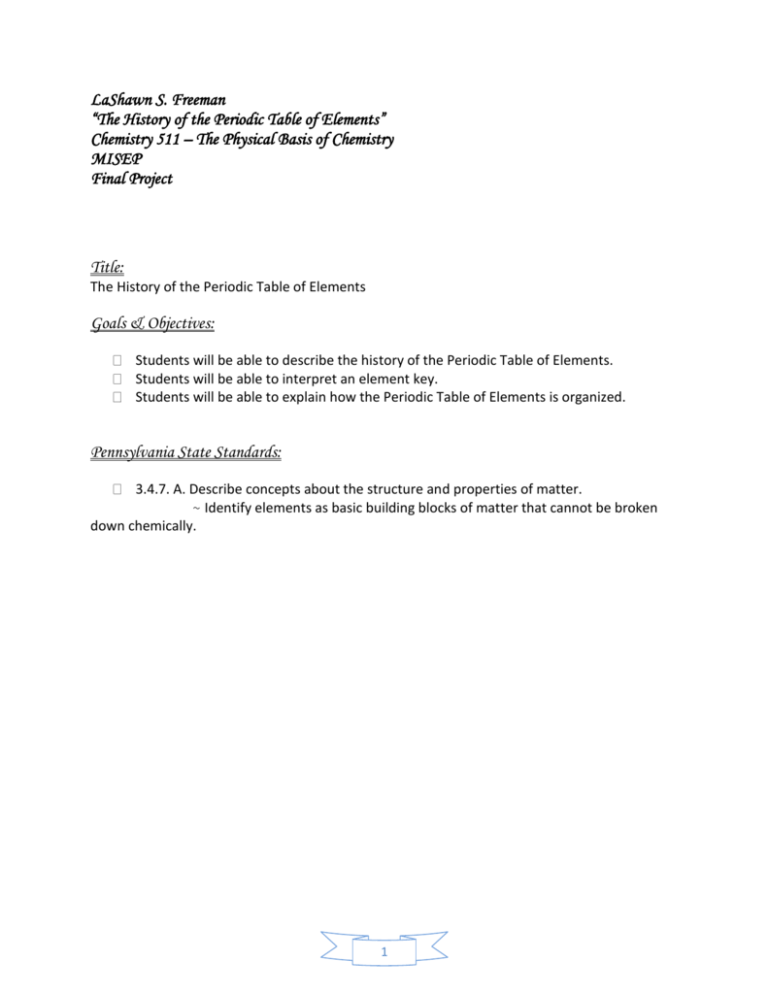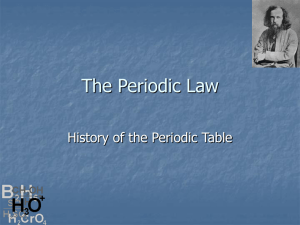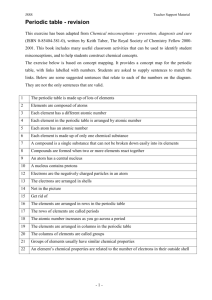Chemistry 511
advertisement

LaShawn S. Freeman “The History of the Periodic Table of Elements” Chemistry 511 – The Physical Basis of Chemistry MISEP Final Project Title: The History of the Periodic Table of Elements Goals & Objectives: Students will be able to describe the history of the Periodic Table of Elements. Students will be able to interpret an element key. Students will be able to explain how the Periodic Table of Elements is organized. Pennsylvania State Standards: 3.4.7. A. Describe concepts about the structure and properties of matter. ~ Identify elements as basic building blocks of matter that cannot be broken down chemically. 1 Background Information The Periodic Table was developed in an attempt to organize the elements, which were discovered by scientists with the discovery of atoms. Early philosophers debated, reasoned and discussed the concept of matter. What was it made of? They concluded that you could take a piece of matter and continuously cut it into half again and again until you would only have one particle left. They named this particle “the atom” which means “cannot be divided”. In the 1800’s scientists, called chemists, developed methods used in laboratories that allowed them to take substances apart to figure out what they were made of; as well as mix substances together to form new ones. This type of experimentation caused scientists to discover that some substances could not be broken down into simpler substances. Scientist called these substances elements. In the early 1900’s an English schoolteacher by the name of John Dalton combined the idea of the element with the earlier idea of the atom. He proposed the following; (1) Matter is made up of atoms, (2) atoms cannot be divided into smaller pieces, (3) one type of element is made up of all of the same type of atoms, (4) different elements are made up of different types of atoms. In the 1830’s scientists had isolated and named 55 different elements. A scientist by the name of Dmitri Mendeleev (1834-1907) developed the first version of the periodic table of elements in 1869 in an attempt to organize the elements. In his table Mendeleev arranged the atoms in order of increasing atomic mass onto cards. He placed elements that had similar properties into groups. Because all of the elements were not known at this time there were gaps in his groups. This excited other chemists to look for the missing 2 elements. The discovery of the other three elements took about fifteen years which were gallium, scandium, and germanium. In the early twentieth century, an English physicist by the name of Henry Moseley (1887-1915) realized that Mendeleev’s table could be improved by arranging the table in order of increasing atomic number rather than atomic mass. This is due to a few elements seeming to be out of place. Once Moseley completed the rearrangement of the periodic table of elements it was clear how many elements were missing from the table. Today there are one hundred fourteen known elements arranged on the table; ninety-two are natural elements while twenty-two are synthetic. The elements are still arranged according to their atomic number. Due to the similar characteristics that the elements fall into the table can be sectioned off in a number of ways. If you travel vertically along any column in the table you will come across groups (18 group’s total). Starting from the first element in a group and working your way down you will notice that the atoms of each element gets larger as you travel down the column. While traveling across the table along horizontal rows are called periods (7 period’s total). When traveling across a period from right to left the atom of each element starts off large and gets smaller as you move to the left side of the table. The modern table also naturally groups the elements by metals, non-metals and metalloids; which are non-metals that have a few metal-like properties. These are just a few ways that the table has grouped the elements by arranging them according to atomic number. 3 Lesson #1(2days) The Periodic Table of Elements Anticipatory Set: Ask students to discuss the following questions in a group and to record their answers. Have students share their group responses with the class. What are elements? What are elements made of? What are elements used for? Objective: Inform students that at the end of the lesson they will be able to: Describe the history of the periodic table. Interpret an element key Explain how the periodic table is organized Materials: Glencoe Science Level Blue 2005 Edition ~ Text Book Construction Paper 16 pieces of paper (about ½” by ½”) of mixed colors and shapes for each group of students Ruler Loose Leaf Paper Pencil/Pen Chart Paper Markers Modeling: Mini-Lab: 1) Students will use the ruler to make a grid, with four squares across and four squares down, on sheet of construction paper. 2) Students will distinguish characteristics of the 16 pieces of paper. 3) Students will place a piece of paper in each square of their grid by arranging the pieces on the grid so that each column contains pieces that are similar. 4) Students will then rearrange each column so that within each column they show a gradual change in the pieces appearance as the column goes from top to bottom. 5) Students will answer the question “Describe how the properties change in the rows across the grid and in the columns down the grid?” Students will be informed that all of the elements are listed on the periodic table of elements 4 Students will read, take notes and discuss pages #434-440 (Copy of Pages included) of the Glencoe Science Text as a whole class. “The Periodic Table of Elements” (*See notes at the end of lesson for summary) Guided Practice: Students will answer the following questions; each group will be assigned a question to answer and report out to the class. (Place on chart paper) Evaluate the elements in period 4 to show how the physical state changes as the atomic number increases. Describe where the metals, nonmetals and metalloids are located in the periodic table. How would the modern periodic table of elements be different if the elements were arranged by average atomic mass instead of by atomic number? Classify each of the following elements as a metal, non-metal, or metalloid: Fe, Li, B, Cl, Si, Na, and Ni. Closure: Student will review answers with whole class from guided practice. Independent practice: Students will create their own version of the modern periodic table of elements. o Students are encouraged to keep the basic format of the modern table of elements while adding a touch of creativity on how it will be displayed o Students must create their table on a poster board. *Note: The information the students will obtain by reading the required text from the Glencoe Science text book gives an overview of the periodic table of elements. The reading begins by giving students a brief history of the table including information about how and why it was created first by Dmitri Mendeleev and then improved upon by Henry Moseley; who gave us the modern version of the table. The students will then continue to read information as to the organization of the table gaining knowledge of; groups, periods, transition elements, representative elements and inner transition elements. In the reading students have a chance to see the table in an outline form with information on how the table is presently divided. As well as a version of the table in its entirety with all of the currently known elements listed. 5 Reflection/Assessment Project Students will create a poster board representing any element from the periodic table of elements. Boards must include: I. an element key (including element name, atomic number, symbol & atomic mass) II. a picture of the element III. a list of at least five uses of the element – can include pictures of the element in use IV. a picture of the nuclear atomic structure of the element 6 Bibliography Page Glencoe, McGraw-Hill. (2005) Glencoe Science – Level Blue, Pgs. 434-440 Retrieved April 2008, from http://www.chemistry.co.nz/henry_moseley.htm Retrieved April 2008, from http://www.chemcool.com/biography/moseley.htm Retrieved April 2008, from http://www.chemistry.co.nz/mendeleev.htm Retrieved April 2008, from http://www.rsc.org/education/teachers/learnnet/periodictable/pre16/develop/mendele ev.htm 7






